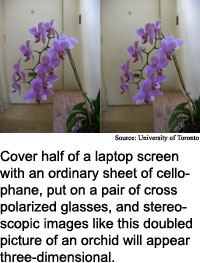
Cellophane turns LCDs 3D
By Eric Smalley, Technology
Research NewsSometimes ordinary items have more to them than meets the eye.
For the past couple of decades research teams have worked to make various types of three-dimensional displays; most methods include fairly complicated hardware.
A researcher from the University of Toronto has taken a different tack. As it turns out, a trip to the kitchen and a pair of polarizing glasses can turn an ordinary laptop screen into a 3D display.
The method could lead to extremely low-cost three-dimensional applications for scientific and medical imaging, and for games, according to Keigo Iizuka, a professor emeritus of electrical and computer engineering at the University of Toronto.
Iizuka's tests verified that a sheet of ordinary cellophane possesses the properties necessary to rotate the direction of white light polarization 90 degrees. Polarization has to do with the electric field of a lightwave. This electric field vibrates in a plane perpendicular to the direction of the light beam, and polarized light vibrates in only one direction in this plane. Glare is light that becomes horizontally polarized by reflecting off a surface, and sunglasses work by blocking horizontally-polarized light.
The combination of a computer screen showing two copies of an image that are polarized differently and a pair of glasses that blocks light polarized in different directions for each eye, will allow a viewer to see a different copy of the image with each eye.
This creates the illusion of three dimensions because the human brain judges distances based on the differences in the views seen by each eye.
Iizuka's method takes advantage of a property of the liquid crystal displays used in laptops and flat screen monitors. The top layers of the displays are polarizer sheets, which block polarized light that has been rotated by the liquid crystals that form characters and other marks on the screen, but let through the background light that remains polarized parallel to the polarizer sheets.
Because the light coming from a screen is already polarized, it is possible to rotate the polarization of the light coming from one half of the screen 90 degrees by simply covering that side with cellophane, said Iizuka. "The advantage of such a 3D display is that it is easy to fabricate with readily available components at minimum cost," he said.
The colorless, 25 micron-thick cellophane the researchers tested was better than the commercial half-wave plates usually used for the job, according to Iizuka. "Cellophane's performance in rotating the direction of polarization of white light was superior to that of commercially available half-waveplates designed for a specific wavelength," he said.
Half-waveplates of the size needed to turn a laptop into three-dimensional display also cost 3,500 times that of an appropriately-sized sheet of cellophane, Iizuka said.
Cellophane's polarization properties are a byproduct of the strain it bears during its fabrication process. Cellophane is made by extruding a cellulose solution through a narrow slit into an acid bath, said Iizuka. The unidirectional strain during the extruding process makes cellophane an anisotropic material that behaves like a calcite crystal, he said.
Anisotropic materials, which include wood, contain physical properties that are different in different directions. Wood strength, for example, is different along the grain than perpendicular to the grain.
In the case of cellophane, the refractive index of light, meaning the amount that light is bent as it passes through the material, is different in different directions. This makes light polarized in one direction pass through the cellophane at a different speed than light polarized in the other direction. "After transmission through such a medium, a phase difference arises between the two types of light," said Iizuka.
The refractive index and the thickness of the cellophane determine the amount of the phase difference between the components polarized in the x and y directions, said Iizuka. The 25 micron thickness used in kitchen cellophane turns out to make the phase difference 170.2 degrees -- close enough to the 180 degree phase shift needed to rotate the polarization by 90 degrees. Twenty-five microns is about a third of the thickness of a human hair.
Not only is cellophane available at an extremely low cost, said Iizuka, it is available in large sheets, making very large three-dimensional displays possible.
In addition, the necessity of wearing polarized glasses can be eliminated by replacing them with a large crossed polarizer sheet suspended between the screen and the observer, said Iizuka. "In other words, let the computer wear the glasses," he said. This is possible in applications that have only one viewer at a time, he added.
Iizuka is working on making the technique more suitable for displaying sign language, he said.
The work appeared in the August, 2003 issue of the Review of Scientific Instruments.
Timeline: Now
Funding: University
TRN Categories: Data Representation and Simulation; Applied Technology; Graphics
Story Type: News
Related Elements: Technical paper, "Using Cellophane to Convert a Laptop Computer Screen into Three-dimensional Display," Review of Scientific Instruments, August, 2003.
Advertisements:
August 27/September 3, 2003
Page One
Software speeds modeling
DNA plays tic-tac-toe
Email updates six degrees theory
Cellophane turns LCDs 3D
News briefs:
Detector senses single DNA
Crystal shortens infrared waves
Tool sketches quantum circuits
Nanotubes spark gas detector
Metal process makes heat chips
Light makes molecule shine

News:
Research News Roundup
Research Watch blog
Features:
View from the High Ground Q&A
How It Works
RSS Feeds:
News
Ad links:
Buy an ad link
| Advertisements:
|
 |
|
TRN
Newswire and Headline Feeds for Web sites
|
© Copyright Technology Research News, LLC 2000-2011. All rights reserved.